
table of contents
Organic Acids test
Organic Acids test results in November 2020
the first page
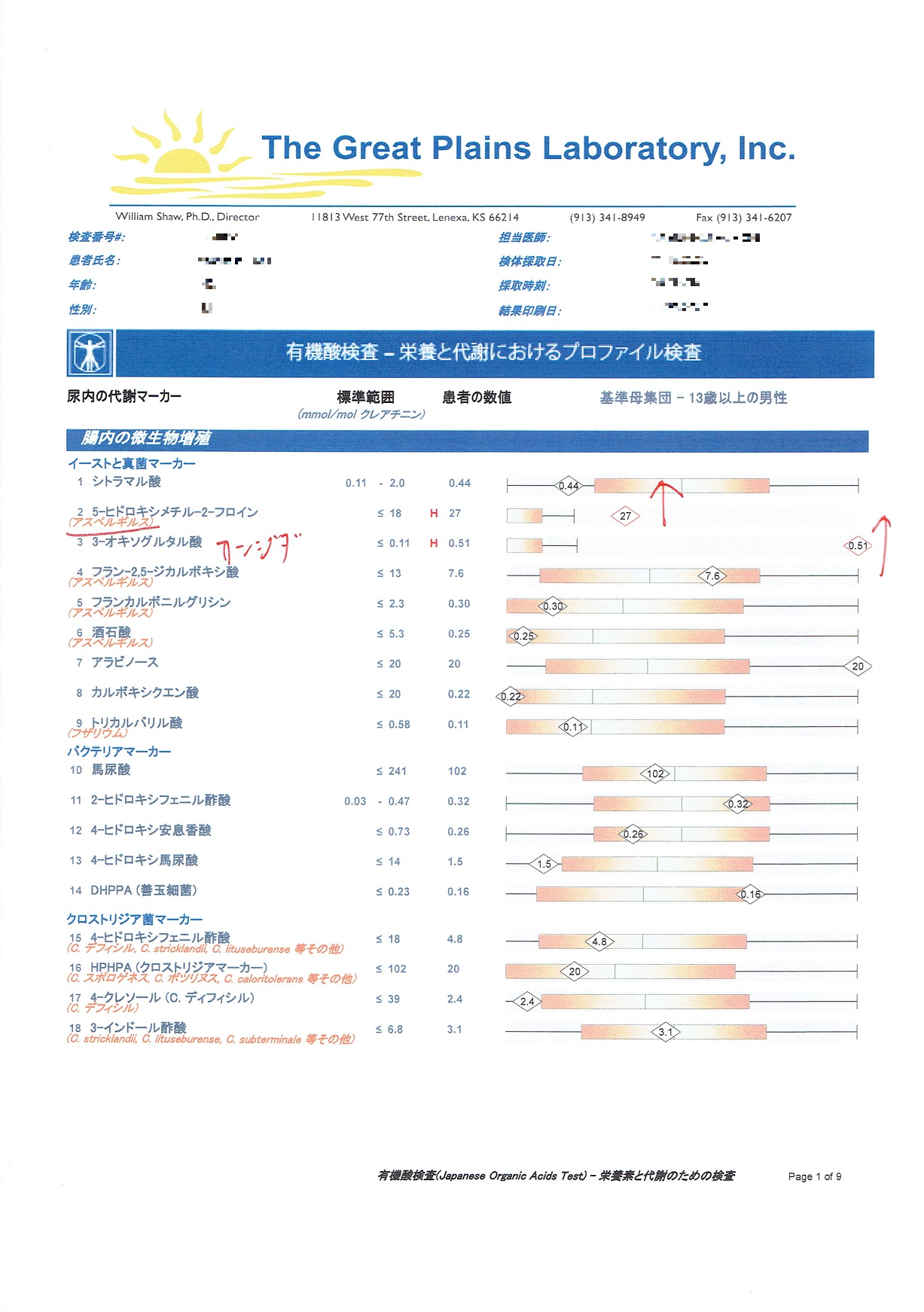
This is the first page of the Organic Acids test results.
Organic Acid Testing-Profile Testing in Nutrition and Metabolism
Growth of microorganisms in the intestine
Yeast and fungal markers
1 Citramalic acid
2 5-hydroxymethyl-2-furoic
(Aspergillus)
3 3-oxoglutarate
4 Furan-2.5-dicarboxylic acid
(Aspergillus)
5 Furancarbonylglycine
(Aspergillus)
6 Tartaric acid
(Aspergillus)
7 Arabinose
8 Carboxycitric acid
9 Tricarballylic acid
(Fusarium)
Bacterial marker
10 Hippuric acid
11 2-hydroxyphenylacetic acid
12 4-hydroxybenzoic acid
13 4-hydroxyhippuric acid
14 DHPPA (good bacteria) 3,4-dihydroxyphenylpropionic acid
Clostridia marker
15 4-hydroxyphenylacetic acid
(C.difficile,C.stricklandii,C.lituseburense,etc. Others)
16 HPHPA 3-(3-hydroxyphenyl)-3-hydroxypropanoic acid
(C.spologenes,C.botulinumetc,C.caloritolerans,etc. Others)
17 4-cresol
(C.difficile)
18 3-indole acetic acid
(C.stricklandii,C.lituseburense,C.subterminale,etc. Others)
2nd page
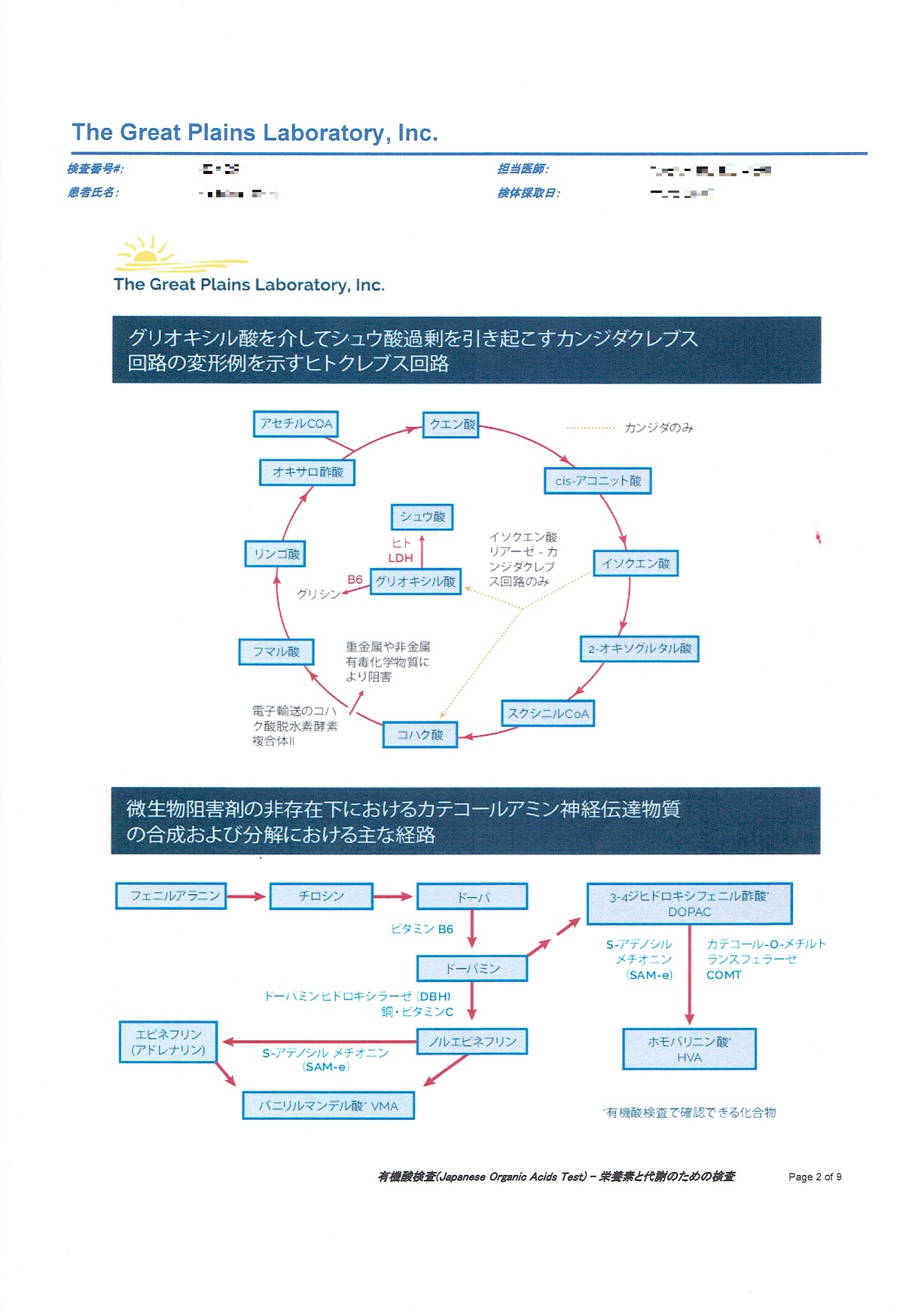
Human Krebs cycle showing a modified example of the Candida Krebs cycle that causes oxalic acid excess via glyoxylic acid
Major pathways in the synthesis and degradation of catecholamine neurotransmitters in the absence of microbial inhibitors
3nd page
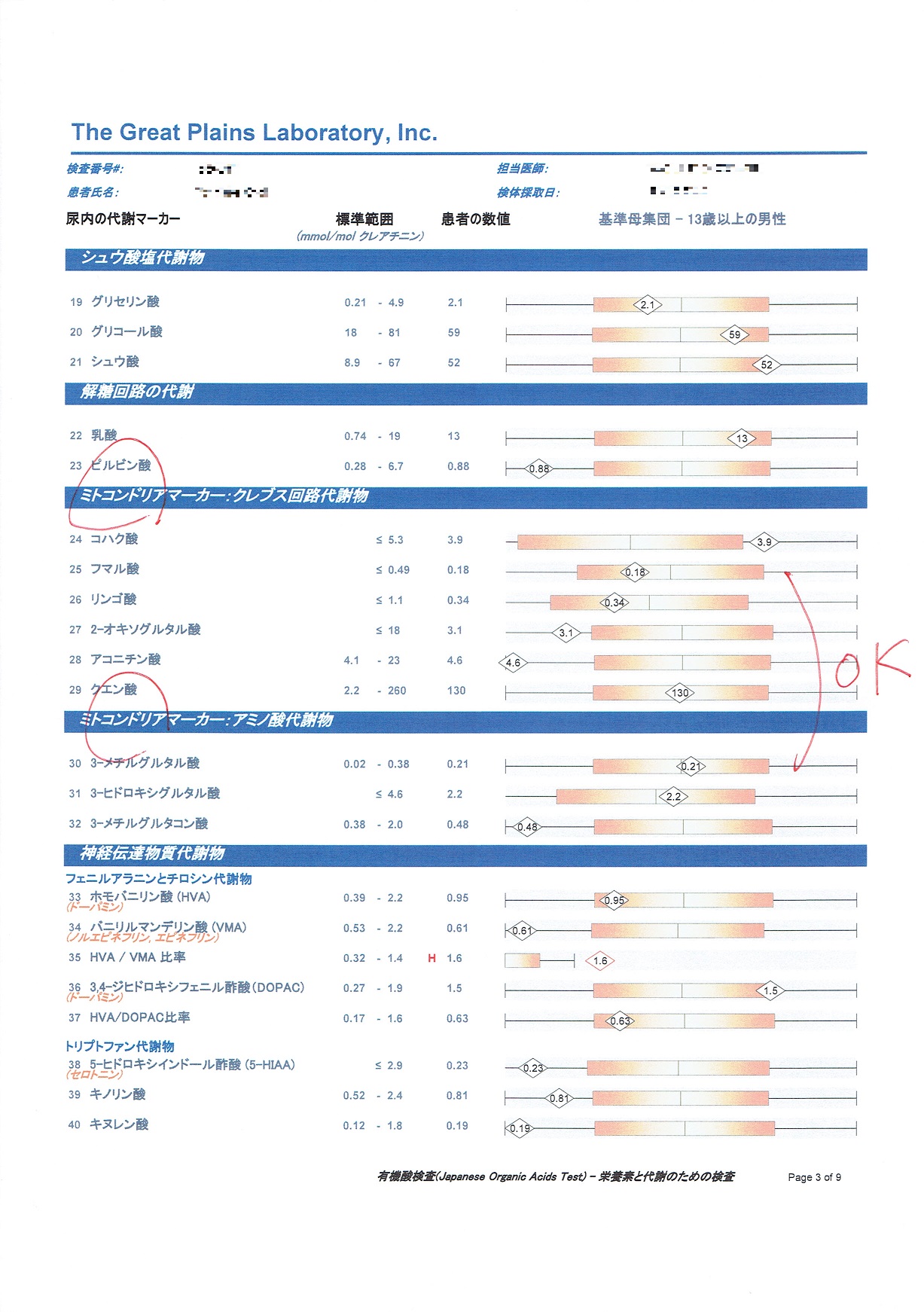
Oxalic acid metabolite
19 Glyceric acid
20 Glycolic acid
21 Oxalic acid
Glycolytic circuit metabolism
22 Lactic acid
23 Pyruvate
Mitochondrial marker: Krebs cycle metabolites
24 Succinic acid
25 Fumaric acid
26 Malic acid
27 2-oxoglutarate
28 Aconitic acid
29 citric acid
Mitochondrial markers: amino acid metabolites
30 3-methyl glutaric acid
31 3-hydroxyglutaric acid
32 3-methylglutaconic acid
Neurotransmitter metabolites
Phenylalanine and tyrosine metabolites
33 Homovanillic acid (HVA)
(Dopamine)
34 Vanillyl mandelic acid (VMA)
(Norepinephrine, epinephrine)
35 HVA / VMA ratio
36 3,4-dihydroxyphenylacetic acid (DOPAC)
(Dopamine)
37 HVA / DOPAC ratio
Tryptophan metabolite
38 5-hydroxyindole acetic acid (5-HIAA)
(Serotonin)
39 Quinolinic acid
40 Kynurenic acid
4nd page
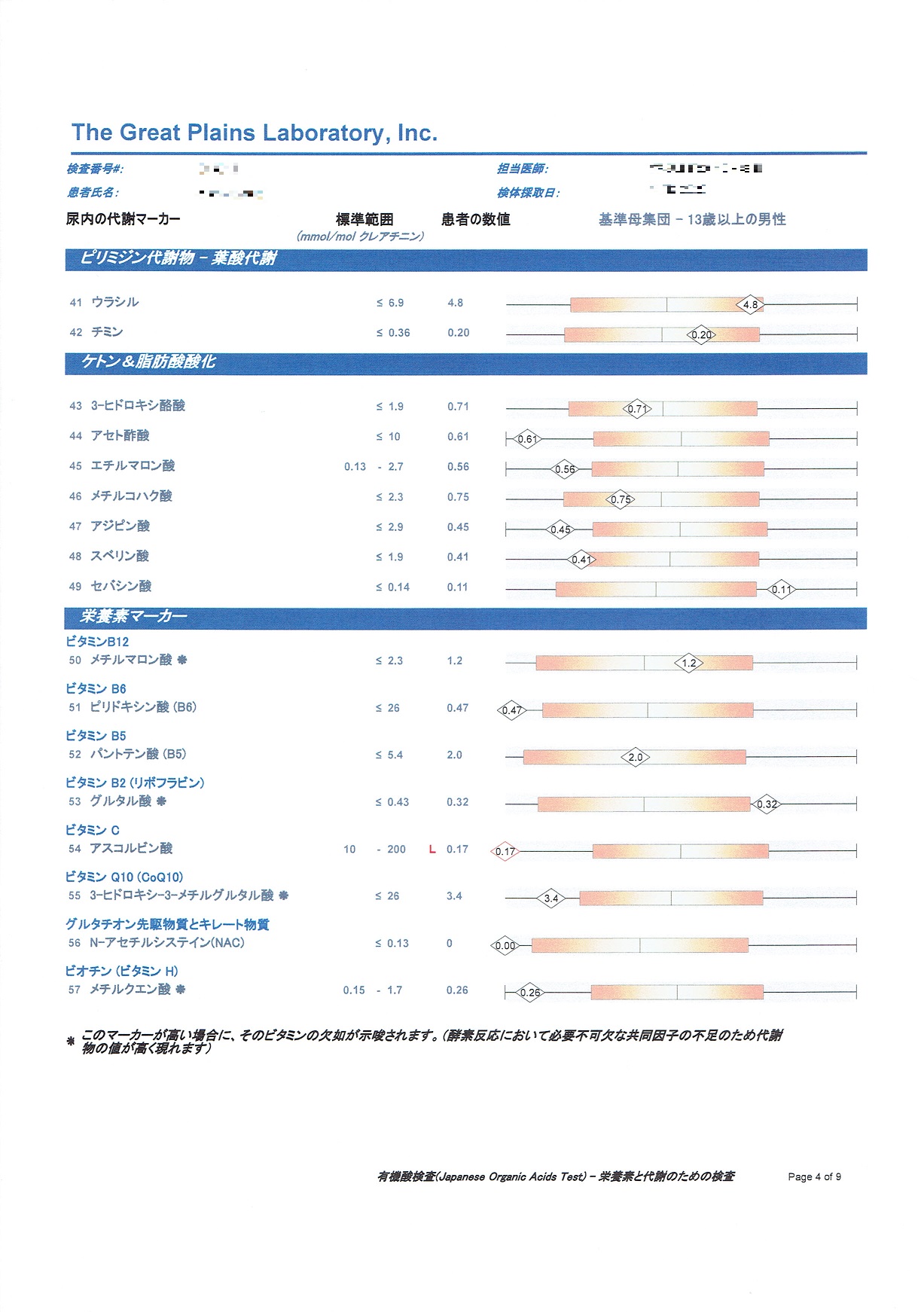
Pyrimidine metabolites-folate metabolism
41 Uracil
42 Thymine
Ketone & fatty acid oxidation
43 3-hydroxyacetic acid
44 Acetoacetic acid
45 Ethylmalonic acid
46 Methylsuccinic acid
47 Adipic acid
48 Suberic acid
49 Sebacic acid
Nutrition marker
Vitamin B12
50 Methyl malonic acid *
Vitamin B6
51 Pyridoxic acid (B6)
Vitamin B5
52 Pantothenic acid (B5)
Vitamin B2 (lipoflavin)
53 Glutaric acid *
Vitamin C
54 Ascorbic acid
Vitamin Q10 (CoQ10)
55 3-hydroxy-3-methyl glutaric acid *
Glutathione precursors and chelating substances
56 N-acetyl-L-cysteine (NAC)
Biotin (vitamin H)
57 Methyl citric acid *
* high value for this marker indicates a vitamin deficiency.(High levels of metabolites appear as there are no essential cofactors for enzymatic reactions)
5nd page
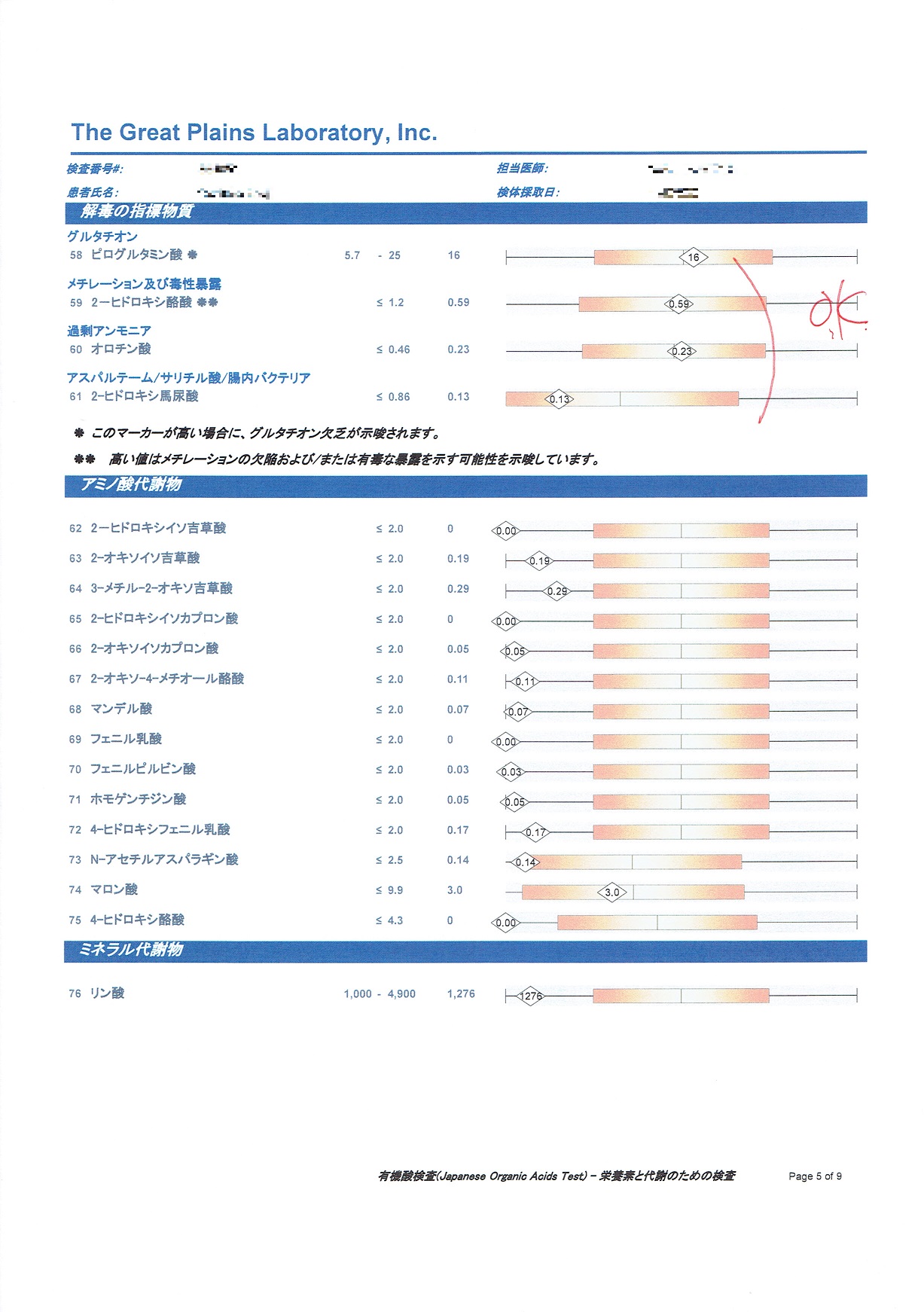
Substances that are indicators of detoxification
Glutathione
58 Pyroglutamic acid *
59 2-hydroxyacetic acid **
Excess ammonia
60 Orotic acid
Aspartame / salicylic acid / enteric bacteria
61 2-hydroxyhippuric acid
* High levels of this marker suggest glutathione deficiency.
** High values suggest that methylation defects and / or toxic exposure may be indicated.
Amino acid metabolites
62 2-hydroxyisovaleric acid
63 2-oxoisovaleric acid
64 3-methyl-2-oxovaleric acid
65 2-hydroxyisocaproic acid
66 2-oxoisocaproic acid
67 2-oxo-4-methylbutyric acid
68 Mandelic acid
69 Phenyl lactic acid
70 Phenylpyruvic acid
71 Homogentisic acid
72 4-hydroxyphenyl lactic acid
73 N-acetyl asparagine
74 Malonic acid
75 4-Hydroxybutyric acid
Mineral metabolites
76 phosphoric acid
6nd page (description)
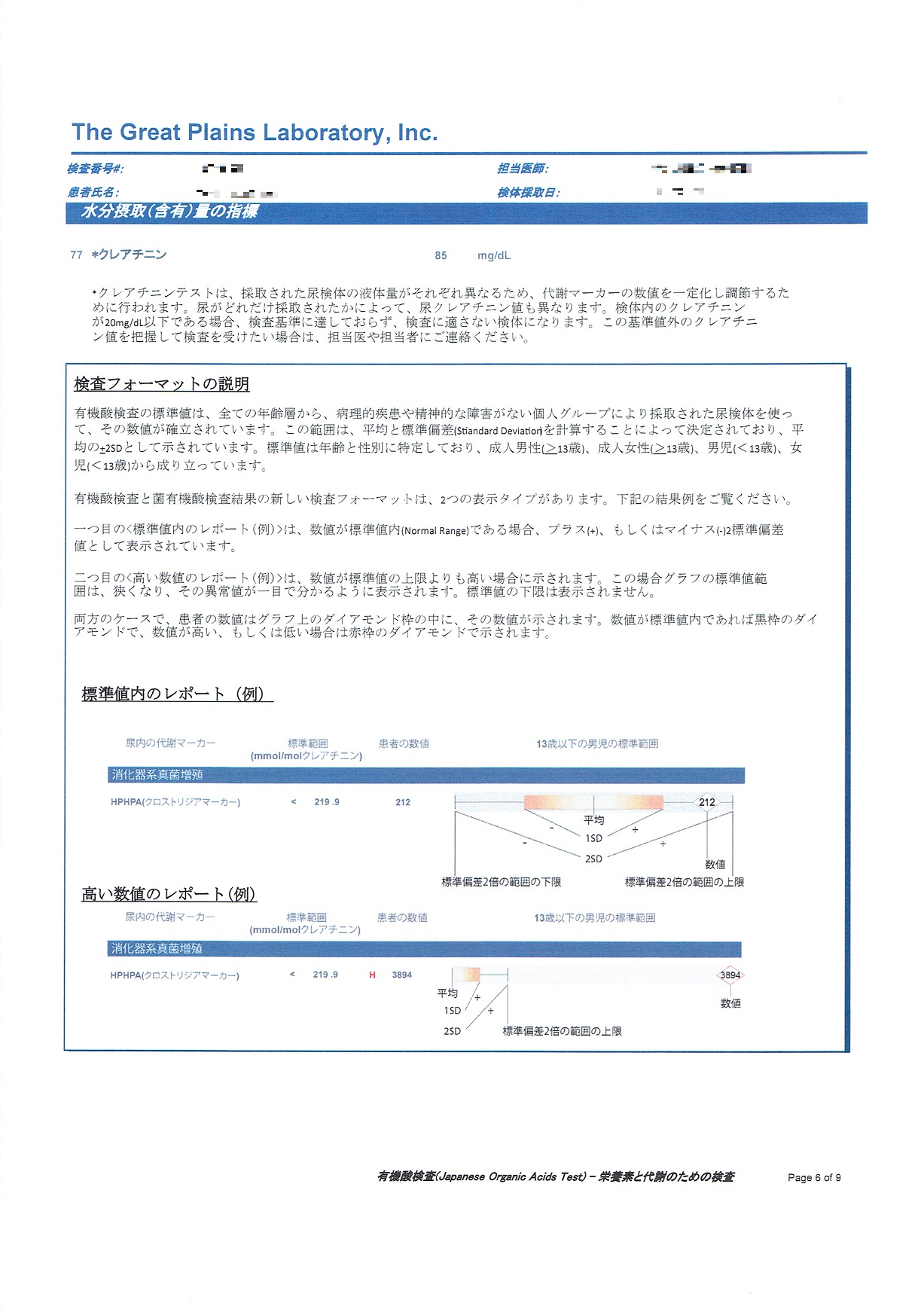
Index of water intake (content)
77 *Creatinine
*Since urine samples collected have different body fluid volumes, the creatinine test is used to stabilize and adjust the number of metabolic markers.
Urinary creatinine levels also vary depending on how much urine is collected.
If the amount of creatinine in the sample is less than 20 mg / dL, the sample does not meet the test criteria and is not suitable for testing.
If you want to test with a creatinine value other than this standard value, please consult your doctor or staff.
Inspection format description
Standard values for organic acid tests are established using urine samples taken by groups of individuals without morbidity or mental illness from all age groups.
This range is determined by calculating the mean and standard deviation and is displayed as ± 25D of the mean.
The standard values are specified by age and sex, and consist of adult males (≧ 13 years old), adult females (≧ 13 years old), boys (<13 years old), and girls (<13 years old).
The new test format for organic acid test and microbial organic acid test result has two display types.
See example results below.
In the first example, when the numerical value is within the standard value (Normal Range), it is displayed as plus (+) or minus (-) 2 standard deviation value.
The second example is displayed when the number exceeds the standard upper limit.
In this case, the reference value range of the graph is narrowed and the abnormal value is displayed so that it can be seen at a glance.
The lower limit of the standard value is not displayed.
In both cases, the patient number is shown in the diamond box on the graph.
If the numerical value is within the standard value, it will be displayed with a black framed diamond, and if the value is high or low, it will be displayed with a red framed diamond.
Report within the standard value (example)
Report outside standard value (example)
7nd page
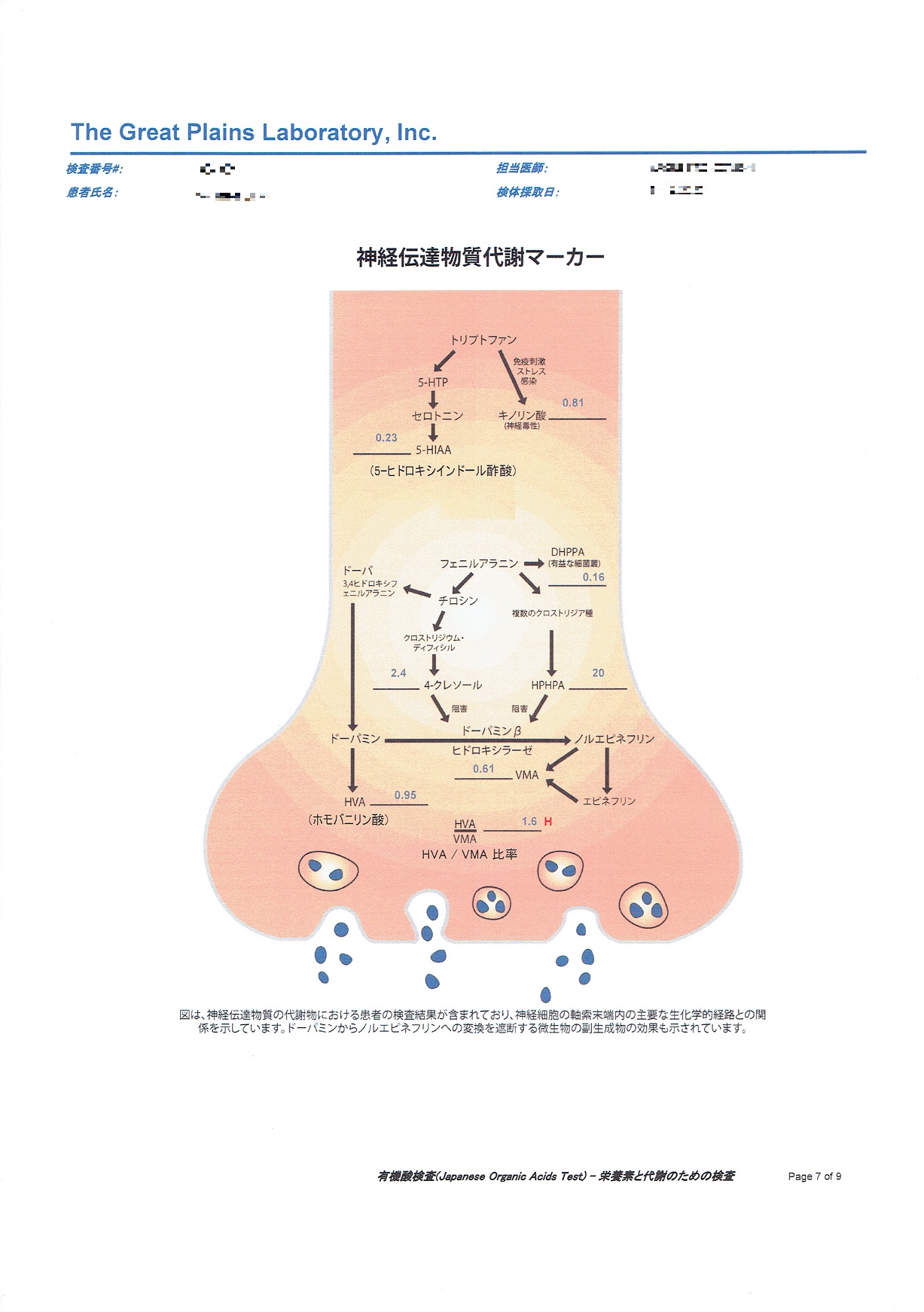
Neurotransmitter metabolism marker
The figure contains patient test results for neurotransmitter metabolites and shows their relationship to the major biochemical pathways within the axon terminals of neurons.
The effect of microbial byproducts that block the conversion of dopamine to norepinephrine has also been shown.
8nd page
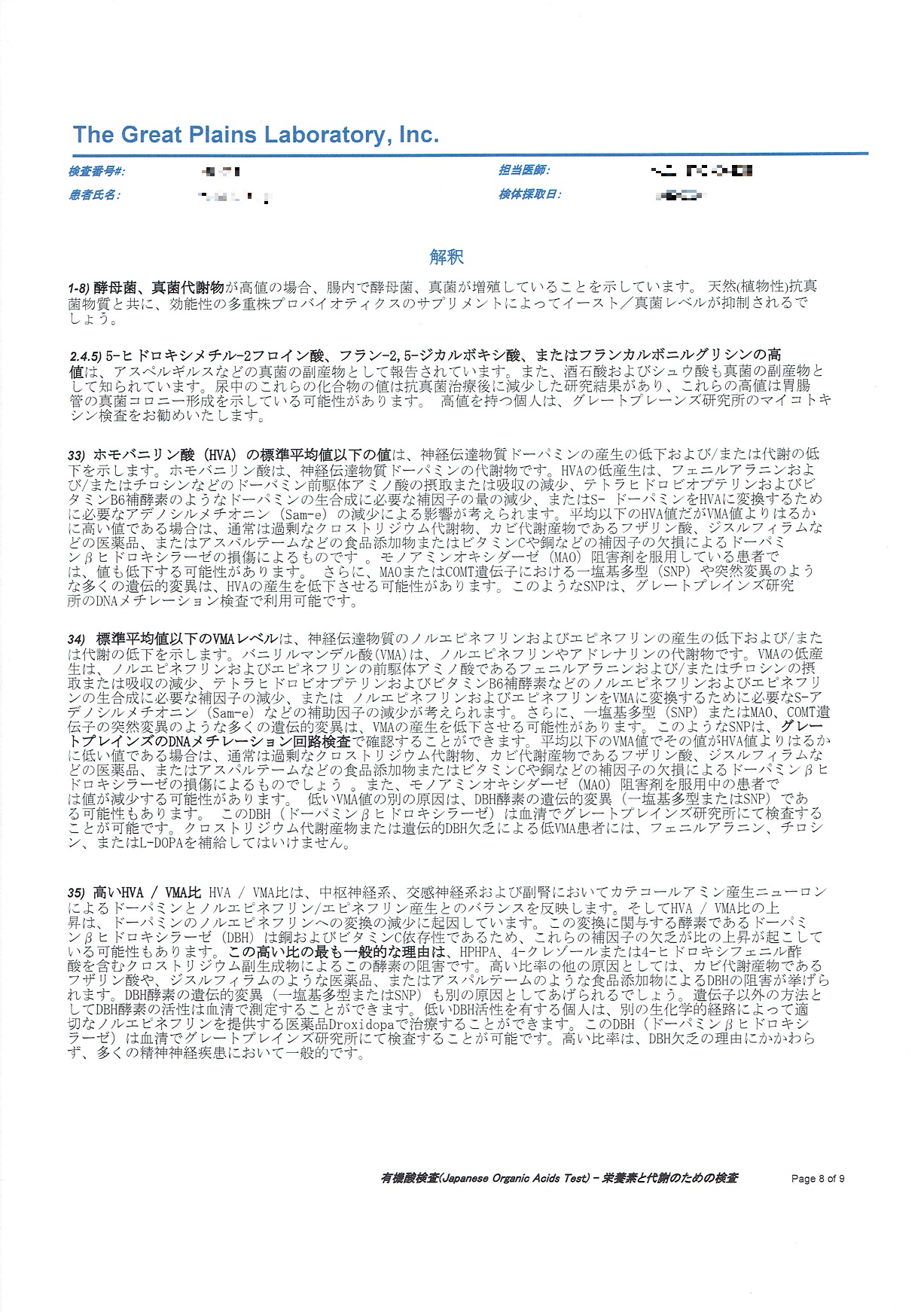
Interpretation
*1-8) High levels of yeast and fungal metabolites indicate that yeast and fungi are growing in the intestine.
Yeast / fungal levels will be suppressed by potent multi-strain probiotic supplements along with natural (vegetable) antifungal substances.
2.4.5) High levels of 5-hydroxymethyl-2 froic acid, furan-2,5-dicarboxyic acid, or furancarbonylglycine have been reported as by-products of fungi such as Aspergillus.
Tartaric acid and oxalic acid are also known as fungal by-products.
Studies have shown that the levels of these compounds in urine decreased after antifungal treatment, and these high levels may indicate fungal colonization of the gastrointestinal tract.
Individuals with high levels are advised to test for mycotoxins at the Great Plains Institute.
33) Below the standard average of homovanillic acid (HVA), a decrease in the production and metabolism of the neurotransmitter dopamine is indicated.
Homovanillic acid is a metabolite of the neurotransmitter dopamine.
Low production of HVA reduces the uptake or absorption of dopamine precursor amino acids such as phenylalanine and tyrosine, reduces the amount of cofactors required for dopamine biosynthesis such as tetrahydrobiopterin and vitamin B6 coenzyme, or reduces S-dopamine. It may be affected by a decrease in adenosylmethionine (Sam-e) required to convert to HVA.
If the HVA value is below average but much higher than the VMA value, it is usually caused by excess crotridium metabolites, mold metabolites such as fuzaphosphate, disulfiram and other food additives, and aspartame and other food additives. Or it is due to damage to dopamine β-hydroxylase due to deficiency of cofactors such as vitamin C and copper.
Values may also decrease in patients taking monoamine oxidase (MAO) inhibitors.
In addition, many genetic mutations, such as single nucleotide polymorphisms (SNPs) and mutations in the MOA or COMT gene, can reduce HVA production.
Such SNPs are available for DNA methylation testing at the Great Plains Institute.
34) Below-standard VMA levels indicate reduced production of the neurotransmitters norepinephrine and epinephrine and reduced metabolism.
Vanillylmandelic acid (VMA) is a metabolite of norepinephrine and adrenaline.
Low VMA production results in decreased uptake or absorption of norepinephrine and the precursor amino acids phenylalanine and tyrosine, decreased cofactors required for norepinephrine and epinephrine biosynthesis such as tetrahydrobiopterin and vitamin B6 coenzyme, or norepinephrine. And a decrease in cofactors such as S-adenosylmethionine (Sam-e) required to convert epinephrine to VMA is possible.
In addition, many genetic mutations, such as single nucleotide polymorphisms (SNPs) or mutations in the MAO and COMT genes, can reduce VMA production.
Such SNPs can be confirmed by a DNA methylation circuit test in the Great Plains.
If the VMA value is below average and the value is much lower than the HVA value, it is usually an excess of crotridium metabolites, the mold metabolite fuzaric acid, or pharmaceuticals such as disulfiram, food additives such as aspartame. Or it may be due to damage to dopamine β-hydroxylase due to deficiency of cofactors such as vitamin C and copper.
It may also decrease in patients taking monoamine oxidase (MAO) inhibitors.
Another cause of low VMA levels may be a genetic variation of the DBH enzyme (single nucleotide polymorphism or SNP).
This DBH (dopamine β hydroxylase) can be tested in serum at the Great Plains Institute.
Patients with low VMA due to Clostridium metabolites or genetic DBH deficiency should not be supplemented with phenylalanine, tyrosine, or L-DOPA.
35) High HVA / VMA ratio The HVA / VMA ratio reflects the balance between dopamine and norepinephrine / epinephrine production by catecholamine-producing neurons in the central nervous system, exchange nervous system and adrenal glands.
And the increase in the HVA / VMA ratio is due to a decrease in the conversion of dopamine to norepinephrine.
The enzyme involved in this conversion, dopamine β-hydroxylase (DBH), is copper- and vitamin C-dependent, so deficiency of these cofactors may cause an increase in the ratio.
The most common reason for this high ratio is inhibition of this enzyme by Clostridium by-products containing HPHPA, 4-cresol or 4-hydroxyphenylacetic acid.
Other causes of the high proportion include inhibition of DBH by the fungal metabolite fuzaric acid, medicines such as disulfiram, or food additives such as aspartame.
Genetic variation of the DBH enzyme (single nucleotide polymorphism or SNP) may be another cause.
As a method other than genes, the activity of DBH enzyme can be measured in serum.
Individuals with low DBH activity can be treated with the drug Droxidopa, which provides the appropriate norepinephrine by another biochemical pathway.
This DBH (dopamine β hydroxylase) can be tested in serum at the Great Plains Institute.
High rates are common in many neuropsychiatric disorders, regardless of the reason for DBH deficiency.
9nd page
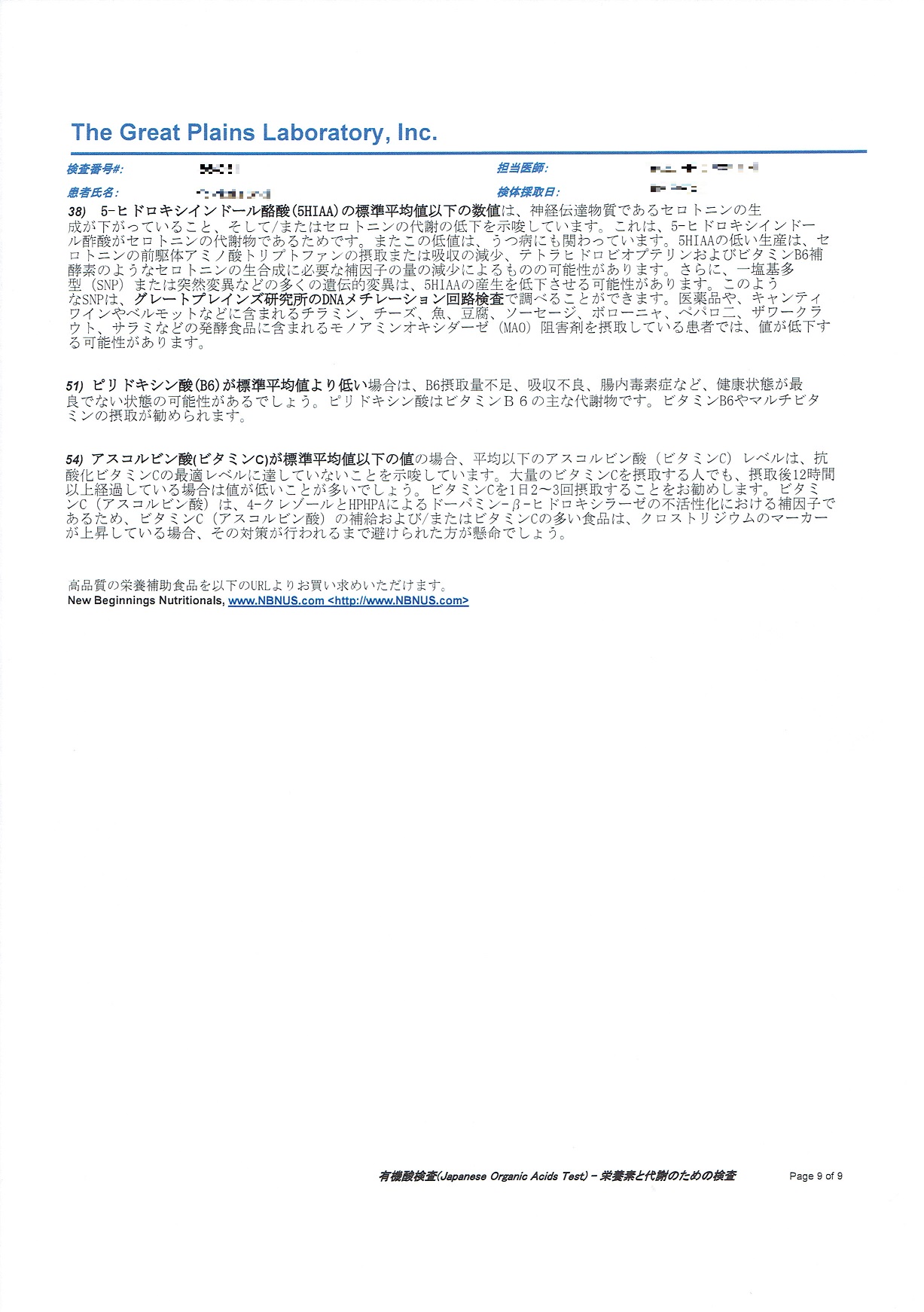
38) Below the standard average of 5-hydroxyindole butyric acid (5HIAA), the production of the neurotransmitter serotonin is reduced and the metabolism of serotonin is reduced.
This is because 5-hydroxyindoleacetic acid is a metabolite of serotonin.
This low value is also associated with depression.
The low production of 5HIAA may be due to a decrease in the uptake or absorption of the serotonin precursor amino acid tryptophan, and a decrease in the amount of cofactors required for serotonin biosynthesis, such as tetrahydrobiopterin and vitamin B6 coenzyme.
In addition, many genetic mutations, such as single nucleotide polymorphisms (SNPs) or mutations, can reduce 5HIAA production.
Such SNPs can be examined by a DNA methylation circuit test at the Great Plains Institute.
The levels may decrease in patients taking medicines, tyramine in wine, and monoamine oxidase (MAO) inhibitors in fermented foods.
51) If pyridoxine acid (B6) is below the standard average, you may be in poor health, such as insufficient B6 intake, malabsorption, or dysbiosis.
Pyridoxine acid is the main metabolite of vitamin B6.
Vitamin B6 and multivitamin intake are recommended.
54) Subnormal ascorbic acid (vitamin C) levels suggest that below-average ascorbic acid (vitamin C) levels do not reach optimal levels of antioxidant vitamin C.
Even people who take large amounts of vitamin C will often have low levels if more than 12 hours have passed since they were taken.
It is recommended to take vitamin C 2-3 times a day.
Vitamin C (ascorbic acid) is a cofactor in the inactivation of dopamine-β-hydroxylase by 4-cresol and HP PA.
Vitamin C (ascorbic acid) supplements and foods high in vitamin C, if elevated Clostridium markers, should be avoided until countermeasures are taken.